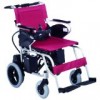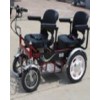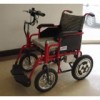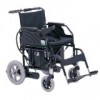来自上海葛兰素史克研究中心与美国Baylor医学院的科学家最近在Th17的研究方面取得新的进展,相关成果文章公布在最新一期的Nature Medicine上。
2005年Th17概念提出,由于其表达的细胞因子和生物学功能、分化过程完全不同于Th1、Th2细胞,且Th17在慢性感染和自体免疫疾病过程中发挥重要的作用,因此,一经发现Th17就引起了研究者们浓厚的兴趣。
Th17细胞能够分泌产生IL-17A、IL-17F、IL-6以及肿瘤坏死因子α(tumor necrosis factor α,TNF-α)等,其功能主要就体现在它分泌的这些细胞因子集体动员、募集及活化中性粒细胞的能力上。Th17细胞产生的最重要的效应因子是IL-17, 其受体在体内广泛表达。虽然Th17细胞在自身免疫病中的病理性作用得到了证实, 但研究者们认为这并不是它们的主要的原始功能。当出现感染或炎症等严重伤害的早期,机体都需要中性粒细胞参与阻止组织坏死或者脓血症。而Th17细胞产生的IL-17能有效地介导中性粒细胞动员的兴奋过程,从而有效地介导了前炎症反应。
研究发现,过量的Th17细胞会引发严重的自体免疫疾病,比如多发性硬化症(multiple sclerosis)。了解Th17在自体免疫疾病的发生发展过程中的作用机制对治疗自体免疫疾病具有重要的意义。
Jingwu Zhang等人发现,一种关键的细胞因子IL-7是维持Th17细胞存活与扩撒的关键因子。他们研究发现,用IL-7受体拮抗剂可有效地抑制多发性硬化症的发病过程,经过IL-7受体拮抗剂的应用,过量的Th17细胞更易进入凋亡状态,有助减少有害的Th17细胞。
研究人员深入地分析IL-7与IL-7R(IL-7 receptor)对Th17发育的关键机制。他们发现,患有实验性自身免疫性脑脊髓炎的小鼠与患有多发性硬化症的人类在接受IL-7后Th17细胞的数量显著增多。
而,对小鼠或是人类给予IL-7R拮抗剂治疗后,分化后的Th17细胞变得更易进入细胞凋亡程序,这可有效地缓解自体免疫疾病的发展过程。
研究者还发现IL-7对其他类型的辅助性T细胞和调节性T细胞没有类似的功效。
研究者认为,IL-7可能是治疗多发性硬化症的一个潜在靶位。(生物谷Bioon.com)
生物谷推荐原始出处:
Nature Medicine 10 January 2010 | doi:10.1038/nm.2077
Crucial role of interleukin-7 in T helper type 17 survival and expansion in autoimmune disease
Xuebin Liu1, Stewart Leung1, Chunxia Wang1, Zhu Tan1, Ji Wang1, Taylor B Guo1, Lei Fang1, Yonggang Zhao1, Bing Wan1, Xia Qin1, Limin Lu1, Runsheng Li1, Heng Pan1, Mingjuan Song1, Ailian Liu1, Jian Hong2, Hongtao Lu1 & Jingwu Z Zhang1
Interleukin-7 receptor (IL-7R) is genetically associated with susceptibility to multiple sclerosis. Here we describe that IL-7 is essential for survival and expansion of pathogenic T helper type 17 (TH17) cells in experimental autoimmune encephalomyelitis (EAE). IL-7 directly expanded effector TH17 cells in EAE and human TH17 cells from subjects with multiple sclerosis, whereas it was not required for TH17 differentiation. IL-7R antagonism rendered differentiated TH17 cells susceptible to apoptosis through the inhibition of Janus kinase–signal transducer and activator of transcription-5 (JAK-STAT5) pathway and altered expression of the prosurvival protein Bcl-2 and the proapoptotic protein Bax, leading to decreased severity of EAE. In contrast, TH1 and regulatory T (Treg) cells were less susceptible to or not affected by IL-7R antagonism in vivo. The selectivity was attributable to minimal expression of IL-7Rα in Treg cells and correlated with a high level of Socs1 (encoding suppressor of cytokine signaling-1) expression in TH1 cells. The study reveals a unique, previously undescribed role of IL-7–IL-7R in TH17 cell survival and expansion and has implications in the treatment of autoimmune disease.
1 Department of Neuroimmunology, GlaxoSmithKline Research and Development Center, Shanghai, China.
2 Department of Neurology, Baylor College of Medicine, Houston, Texas, USA.







